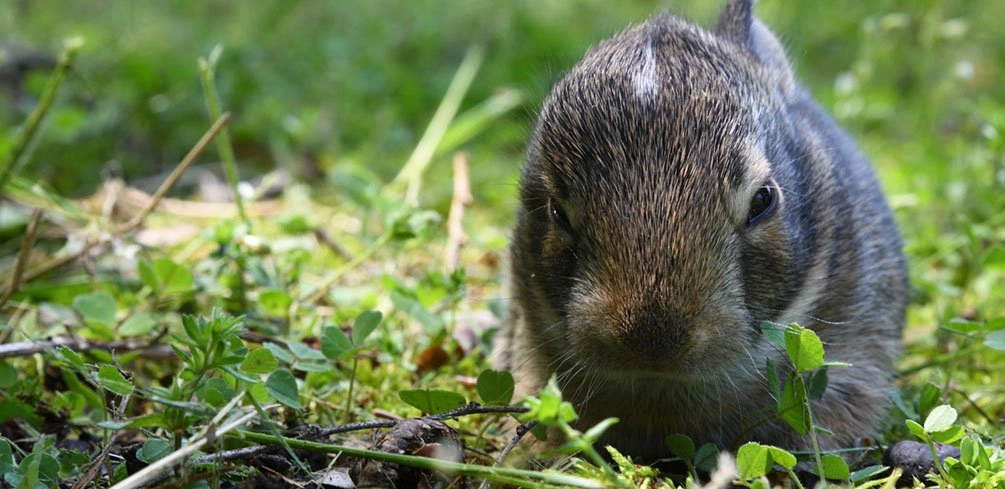Wild baby rabbits leave the nest at 3-weeks old. It takes about three weeks for baby rabbits to develop good eyesight and fur. A rabbit can hop, see, and listen to sounds in the wild when it’s three weeks old.
Rabbits are adorable creatures, and you may be tempted to assist a baby rabbit when you see it in the wild. You need to ask yourself three questions before you help a wild baby rabbit.
- Is the rabbit fully covered in fur?
- Are the eyes open?
- Are the ears alert (upright)?
If your answer to all the questions above is yes, then the rabbit will probably go about its daily activities. Baby rabbits may seem small and vulnerable, but they can take care of themselves in the wild.
Why Do Wild Baby Rabbits Leave the Nest?
Bunny pets do not leave their mother’s side by three weeks, and it may sound unusual that wild rabbits leave the nest so young. However, pet bunnies and wild rabbits live different lives.
Generally, a rabbit can reproduce every four weeks, meaning that it can give birth 12 times a year. Pet rabbits do not produce that much because owners tend to ensure that a doe can rest a while before getting pregnant again.
Wild rabbits take care of kits for 3-weeks and wean them as they prepare for the next litter. Therefore, the baby bunnies have to leave the nest to make room for the next lot. Most baby rabbits spend the first three weeks in the nest for safety. The female wild rabbit ensures that it builds a nest safely before giving birth because the kits can move until they are weaned.
Can Wild Baby Rabbits Survive?
Wild baby rabbits stay in the nest for about 15-20 days before going into the world alone. The first 10 days allow the rabbits to open their eyes, which are shut during birth. The remaining days will enable them to grow fur on their body and breastfeed.
Wild baby rabbits can survive in the wild because they have natural survival instincts. Rabbits have a keen sense of hearing to detect any danger early. Also, they are fast to escape predators in the wild. Unless the baby rabbit is not fully developed or has injuries, they have a good chance of growing to maturity.
What to Do When You Find A Nest?
It is easy to stumble upon a rabbit nest on your property or near a nature trail during breeding seasons. The nests are low and covered with rabbit fur to keep kits comfortable. It would help if you didn’t disturb a nest when you find it. The odds are that the nest is out of the way and hidden from predators.
In case you find kits without a mother in the day, leave them there because mothers tend to find food during the day. Baby rabbits feed at dusk and dawn, and they can survive the day without feeding.
What Should I Do When My Cat/ Dog Finds a Rabbit Nest?
Pets like cats and dogs can find rabbit nests, and sometimes pets can attempt to consume baby rabbits. If your pet finds a rabbit’s nest with kits near your home, you need to add a protective barrier. You should leave a small hole that a doe can fit to get in and out of the nest.
You can use natural materials like branches to create a protective barrier around the nest and keep the baby rabbits safe. Never attempt to relocate a rabbit’s nest because the mother won’t know the new location.
You should check the nest at dawn or dusk to confirm that the mother returned to the nest. If you don’t see the mother the 1-2 day after discovering the nest, you need to call your local wildlife service. Overall, leave the nest intact when a pet finds it and creates some barricade around the nest.
When Should I Help A Baby Rabbit?
Most of the time, it is advisable to leave baby rabbits alone when you come across them. They are capable of taking good care of themselves in the wild. However, some circumstances will require you to help baby rabbits. Also, you should call your local wildlife rehabilitators in case the rabbit is in a bad way.
- You should attempt to return a wild baby rabbit with no fur or with their eyes closed back to the nest. There is a chance that the nest won’t be far away from the location you find a kit. If it is healthy, take it to the nest and leave it there.
- Remove any baby rabbits that may be in a flooded nest. Rabbit nests usually lie on the ground, and they can flood during the rainy season. Call your local wildlife office for assistance.
- Remove baby rabbits from a nest that is infested by pests like ants and fleas. Pests can lead to the death of kits because they are young and defenseless. You should consider calling the exterminator to deal with your pest problem if the nest is on your property.
- Call local wildlife rehabilitators when you find a baby rabbit that is injured lying around. They will be able to nurse the rabbit to health before releasing it back to the wild.
Do not attempt to take care of orphaned or injured baby rabbits if you do not have the training. You should call the local wildlife department and let them take care of orphaned or injured kits. Do not attempt to chase a baby rabbit to assist it. Rabbits get a condition known as capture myopathy due to the stress of being chased or captured. There are no signs of the disease, and the baby rabbit can die shortly after capture. If a baby rabbit runs, let be.
Conclusion
It is natural for wild baby rabbits to be out of the nest and roaming in the forest when they are 15-20 days old. Do not be surprised when you come across a rabbit about the size of a baseball when you are hiking or running at a nature trail.
You should only help a baby rabbit after analyzing the situation and concluding what the rabbit needs. If you are not sure what to do in a scenario involving a baby rabbit, please call your local wildlife service for advice. The best course of action in any situation will be the one that favors wild baby rabbits.
Please be careful and use at your own risk
None of the authors, contributors, administrators, or anyone else connected with PetNudge.com, in any way whatsoever, can be responsible for your use of the information contained in or linked from these web pages.

